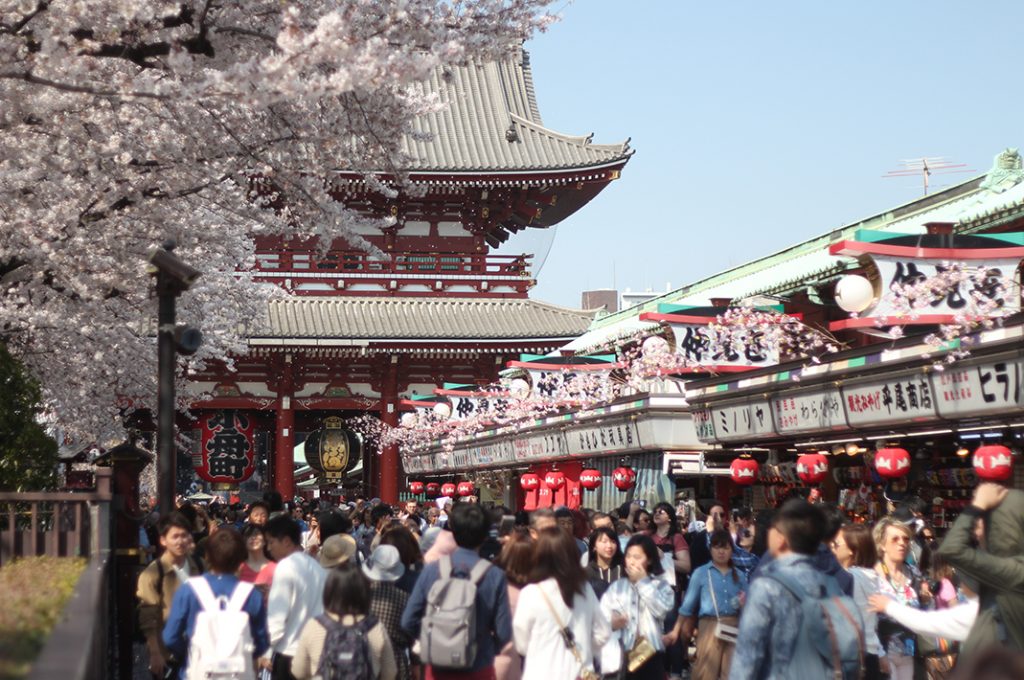After a leisurely boat ride along the Sumida River, you will arrive in Asakusa. The history of this neighborhood dates back to the Edo period. At that time, warehouses used for rice storage filled the neighborhood. At the turn of the 19th century it had become a red-light district, and general amusement area. Today, however, it is most famous for Sensoji Temple. This iconic red temple is a popular tourist spot for domestic and foreign visitors alike. While the temple is certainly impressive, the nearby Kappa-dera as well as the Ushi-jima shrine opposite Sensoji are also worth a visit. This Asakusa tour will take you to these less visited spots; you can find a map of the tour here.
Sensoji and Central Asakusa Tour
There’s no excuse to miss Sensoji temple. Even the most jaded traveler is likely to find the crimson walls and landscaped gardens impressive. Fortunately, it’s hard to miss Sensoji on any Asakusa walk. According to legend, the temple was founded after two local fishermen found a statue of the goddess Kannon in the Sumida River. The temple dates back to 645 and is the oldest extant temple in all of Tokyo. It’s no surprise that it’s now one of the primary tourist hot-spots in the city.

The ferry from Hamarikyu Gardens docks just behind Sensoji temple. From the pier head east and then north until you come to the Thunder Gate, or Kaminarimon. Here statues of the twin deities Fujin and Raijin stand guard over the entrance to the temple. Continuing through the gates, you’ll encounter a long row of stalls selling different wares. This is a great place to stock up on souvenirs for friends and family back home. You can expect to find everything from t-shirts to rice crackers. At the end of the shopping street, you’ll find the temple itself. Usually throngs of tourists will be pushing by one another to get the best pictures. With a little bit of patience, you should get some glimpses of the lavishly decorated temple and its interior.
Kappabashi Street
Make sure you take some time to explore the area around Sensoji Temple. Stores and restaurants pepper the streets and alleys, and you may find some must-visit spots of your own. However, once you’re ready for the next part of the Asakusa Tour, head back to the Thunder Gate. From the gate, head east for ten minutes until you reach a street called Kappabashi-dori. This is the beginning of a street famed for kitchenware, and as you head north, you’ll find a number of stores that specialize in kitchen goods and utensils. Even if you’re not looking to buy kitchen supplies, the stores offer up a museum-like experience. Particularly fun to visit are those that sell painstakingly crafted replicas of food used in restaurant displays.
Kappabshi-Dori
Take a left when you get to Kappabashihon Street and after five minutes you’ll come to Kappa-dera (Kappa Temple), also known properly as Sogenji. The temple is famous for its statues of the mythological Kappa. According to folkore, these amphibious creatures attack humans, though you can always weaken them by emptying the small pool of water on their heads. If you’d rather appease the kappa, cucumbers are their favorite treat, and visitors to the temple frequently leave one or two behind.
Ushijima Shrine
Having narrowly evaded a run-in with a kappa, you’ll want to head east until you hit the water. A little walk south is the pier, but before you think about heading home, head across the bridge to the other side of the Sumida River. On the other side, walk north along the water’s edge and you’ll come to Sumida park. On its northern tip is Ushijima Shrine. While it may seem like a normal Shinto shrine, it’s home to the nade-ushi. This bovine statue has healing powers and is a far cry from the mischievous kappa of the previous temple.
As this shrine is next to the Sumida Park, you should be able to take in the view of Asakusa and relax after completing your walk. On the horizon, the Tokyo Sky tree looms large over the city. The constant presence of such feats of engineering can make it easy to forget about the quieter, sacred, and even mundane spaces of Tokyo’s past. Fortunately, by taking the time to visit some of the remnants of old Tokyo, you should be able to tease some of that history out into the light and see a side of Tokyo that many visitors overlook.
Asakua: https://www.gotokyo.org/en/destinations/eastern-tokyo/asakusa/index.html
Post by Japan Journeys.